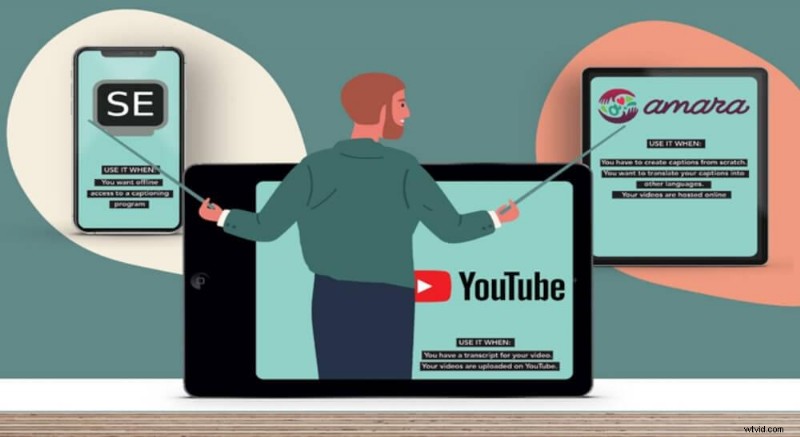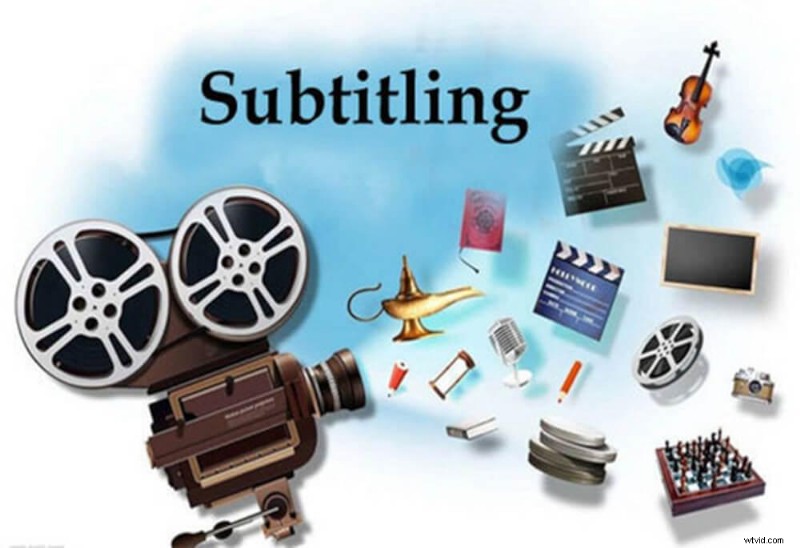Ponieważ ostatecznym celem nauki języka jest możliwość zrozumienia lokalnych użytkowników, należy zwrócić uwagę na prawdziwe media i dyskursy lokalnych mieszkańców. Dla początkujących uczniów jest to często zbyt trudne. Na szczęście napisy sprawiają, że tego rodzaju treści są możliwe nawet dla amatorów. Możesz zdecydować, czy treść z napisami będzie tak prosta, jak i wymagająca, zależnie od potrzeb, więc jest idealna dla wszystkich.
Jeśli chcesz, aby Twoja recenzja była prosta, możesz zasadniczo przeglądać ją podczas oglądania — to takie proste! Jeśli chcesz bardziej godnego uwagi lub większego wyzwania, możesz celowo wyłączyć lub przeoczyć napisy przez ograniczony czas. Możesz skupić się na komunikowanym języku, zdając sobie sprawę, że jeśli potrzebujesz pomocy, napisy są dla Ciebie.
Poza tym oglądanie treści z napisami to prosta metoda przejścia do oglądania wyłącznie w języku docelowym. Jeśli wcześniej nie obserwowałeś wielu autentycznych treści, może to być przytłaczające, niezależnie od tego, czy uczysz się języka od dłuższego czasu.
Jeśli zaczniesz od oglądania treści z napisami, możesz uzyskać odpowiednie informacje potrzebne do zrozumienia prawdziwej mowy w bardziej stabilnym, mniej zastraszającym i niezwykle zabawnym kontekście. Istnieje również sposób, w jaki możesz wybierać między napisami w swoim lokalnym języku a napisami w języku docelowym.

Jak napisy pomagają w nauce nowego języka:
1. Napisy rozwijają Twoje słownictwo

Być może najlepszą zaletą oglądania zagranicznych filmów jest rozwój, który można wgląd w język. Nie tylko zdobędziesz biegłość w unikatowym układzie wyrażeń konwersacyjnych i kolokwializmów, ale także spotkasz je w kontekście.
Zazwyczaj może to być trudne do zdominowania i wymaga czasu, aby przejść przez przekomarzanie się z innymi ludźmi, którzy komunikują się w tym języku. Oglądanie zagranicznych filmów z napisami może przyspieszyć ten proces uczenia się.
2. Napisy zwiększają szybkość czytania i rozumienia ze słuchu
Having the option to comprehend and sort out what you peruse and hear is perhaps the most difficult part of learning another dialect. At the point when a local speaker talks, the sound units of speech connect rapidly and can frequently be undefined to the untrained ear.
Dissimilar to language learning applications or unknown dialect classes that regularly hinder the speaking rate, films with subtitles play at a similar speed as a typical conversation. For new dialect learners, this may feel quick. The advantage of this is that it will extend your listening cognizance and help to increase your reading speed.
3. Visual Nature of Movies Adds an Extra Impact

Movies play an important role regarding learning another dialect. The visual part of the film assists to support listening comprehension alongside vocabulary review. Besides new vocab, you get a visual to connect with it.
This implies that people learn more when watching a film with subtitles than simply paying attention to sound. Another part of the visual idea of films is the inspiration it gives language learning students. When contrasted with pouring over formation cheat sheets, a film feels like a treat.
4. Subtitles Improve Word Recognition and Grammar
While you may know one approach to say regular words like lunch or inn, motion pictures open you to new expressions. Some of which may be more normal than the conventional word you learned. In what way? Usually, unfamiliar movies use less formal slang words that are normal among native speakers.
Perusing subtitles is an incredible way for watchers to grow their jargon. Perusing subtitles as they play on the screen additionally further improves grammar. Exploit the respite catch and stop to examine the captions on the screen. This aids language learners in distinguishing and comprehend verb types, tenses, and phrases. Seeing another dialect in this flighty manner prompts better comprehension.
Advantages of Subtitles in Learning a Foreign Language:

1. Videos in Your Target Language with English Subtitles
There are a few advantages to this method. As a matter of first importance, it opens you to the communicated language, acclimating you to the sounds local speakers use. It is like preparing wheels for unknown dialect perception. You’ll likewise fabricate a relationship between target language words and their implications.
This is presumably the subtitling alternative that most students know about. It empowers you to observe any video in any language and get it, paying little heed to your capability level in that language. You might need to use this technique sparingly, concerning how much it’s working for you.
One examination proposes that students with great listening abilities may be eased back somewhere nearby, using native language subtitles. Slang and idioms can be more difficult in this unique context.
2. Videos in Your Target Language with Subtitles in Your Target Language
The Holy Grail of subtitling alternatives, watching recordings in your targeted language with subtitles in your targeted language is a language student’s dream come true.
It offers a colossal cluster of expected advantages.
- For example, one examination proposes that watching videos in your targeted language with subtitles in the targeted language can work on your discourse, probably by assisting you with helping singular words with their sounds.
- By a similar rationale, it very well may be expected that at the same time hearing and seeing words in your aim language will help your listening abilities. Without subtitles, words in the discourse can appear to run together, however, seeing them worked out can assist you with distinguishing where single word stops and the following word begins.
- It’s additionally an extraordinary chance to learn unfamiliar words in context. The one-two punch of seeing and hearing the dialogue is an extraordinary method to keep new vocabulary. Remember that you can hit “pause” and gaze something upward in the word reference!
3. Videos in English with Subtitles in Your Target Language
Many English-language videos like films offer some unknown dialect subtitling choices. From this, you can get a little understanding practice and may get a couple of new vocabulary words. You can regularly choose a video you’d observe and simply attach the subtitles for a learning bonus.
While it’s anything but as vivid as different alternatives, it’s a very simple and loosened up approach to join your targeted language into your relaxation time. You may decide to use it with some restraint close by other subtitling techniques.
Tips for Learning a New Language by Turning on Subtitles

On the off chance that you are feeling inspired to gain proficiency with another dialect with subtitles? Here’s the way you can begin immediately.
- For novices, start by turning on subtitles while the sound is as yet in your local language. Doing assists with word recognition. When you’re feeling surer, you can change the sound language to a similar language to the subtitles. This will enormously assist with building up the major advantage listed previously.
- Watch short, engaging videos. Czemu? These videos will have less testing vocabulary. Likewise, a three-minute YouTube short can feel significantly less overwhelming than a full-length film. Even though these videos aren’t full-length motion pictures, you’ll get the entire advantages recorded previously.
- Turn on captions for the current series your marathon watching on Netflix. You’re now putting time into this series, why not learn something while you’re busy?
- Do you have a head out to a TV show or film that you know by heart? Turn on subtitles and re-watch them that way. Since you realize the overall plotline, this will make perusing and appreciating those subtitles that a lot simpler.
- Repeat! Discover a film that will be pleasant and persistently watch it until you can talk alongside the actors. This is a shower method for some language learning students.
- Choose a part of the film or show that is engaging to you. To begin with, head up and ingest what’s happening socially. Then, at that point, re-watch it again however this time center on or focus the dialogue. Observe the expressions that are significant to you.
Wnioski

Foreign dialect subtitles are mostly a marginally more powerful examination help than local language subtitles. If, in case you’re a beginner, you ‘re most likely going to require subtitles in the local language from the outset, until you get to a phase where you can adapt to having both the soundtrack and the subtitles be in the unknown dialect.
In case you’re watching films, TV shows, or some other material in your aim unknown dialect, it’s better to watch it with subtitles than without them. Two other accommodating sorts of subtitles are converse subtitles, where unknown dialect subtitles show up along with a local language soundtrack, and double subtitles, where the unknown dialect soundtrack shows up along with subtitles in both the unfamiliar and the local language.
Your selection of subtitles will probably change after some time, as your unknown dialect capability develops. Likewise, various individuals lean toward various kinds of subtitles, so trial to perceive what works for you.
With regard to learning, the primary concern you should focus on is expanding the time went through drawing in with material in your unknown dialect. Thusly, regarding picking which subtitles to use, pick the ones that increment your inspiration to watch things in your unknown dialect, since the more material you watch, the more you will learn.
